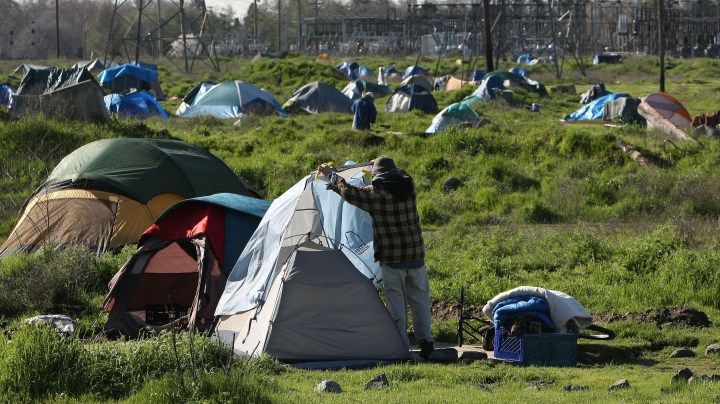
Sacramento considers a “right to housing” for people without homes
Sacramento considers a “right to housing” for people without homes

Michael Hagy said he’d been homeless for about five years. Early December found him inside a one-person camping tent on 15th Street in midtown Sacramento, California, across from a craft brewery and a Quality Inn hotel.
“I take Seroquels for schizophrenic and bipolar” disorders, Hagy said. “I can’t even function, because I can’t pay for them.”
Hagy said he had just arrived at this encampment, where at least six tents have lined the east side of 15th Street since April. The sidewalk wasn’t blocked, but piles of trash spilled over into the street.
Mario Gonzales had to assign his employees at Chando’s Cantina a new role: morning street sweeper. The Mexican restaurant and nightclub is right next door to the encampment.
“Every single morning my team members, they have to clean it up,” Gonzales said. “It’s so hard.”
His frustration is shared by business owners across the city. Compassion fatigue is setting in.
At last official count, in January 2020, more than 580,000 people were homeless in the U.S. Experts say that number has almost certainly grown since the pandemic began. About 25% of America’s homeless population live in California, and more than 11,000 live in its capital, Sacramento.
Mayor Darrell Steinberg feels like he’s in a race against time.
“If we do not make this better, someone will come along and write an initiative that will be draconian, that will be inhumane,” Steinberg said.
He could see even progressive California getting regressive with tactics that involve more law enforcement and criminal penalties.
That is why last year Steinberg proposed a pretty radical solution: Treat housing like public education — a legal right.
“The law requires us to provide free public education to kids and thus requires us to build public schools,” Steinberg said. “If housing people is as important as we say it is, shouldn’t the same right and obligation on us exist?”
Sacramento’s “right to housing” would work like this. If the city doesn’t have enough homeless housing — and it’s currently thousands of beds short — a person experiencing homelessness could sue the city.
Steinberg hopes a court order would speed construction of housing, cutting through the red tape that makes siting new housing enormously time consuming. With unprecedented infusions of state and federal money, the biggest obstacle to making a dent in homelessness is no longer funding, he believes, but a lack of political and bureaucratic urgency.
Advocates for people experiencing homelessness mostly support the idea, except for one controversial part. “So I think it’s coming from a good place. But the obligation to accept, I’m stuck on that,” said Deborah Padgett, a professor of social work at New York University.
Steinberg’s plan would give every person experiencing homelessness a choice — maybe a shelter, maybe a motel room. Each individual who receives temporary shelter would also be put on a path to more permanent housing.
If the homeless person refused, they would be forced to move from their current location.
“They’re going to move, but they’re still going to be out on the streets, and they’ll start an encampment somewhere” else, Padgett said. “So you’re just pushing the problem down the road a bit literally.”
Padgett fears “right to housing” could easily morph into “right to shelter,” New York state’s policy since a 1970s court case. Right to shelter did get people indoors, but Padgett said it didn’t get enough people into permanent housing. It just got them stuck in a homelessness cycle.
“People are living out their lives for years going from shelter to street,” Padgett said. “It’s a horrible way of living.”
Steinberg argues that Sacramento can avoid many of the pitfalls that befell New York.
“People say, ‘Well, New York tried that and failed.’ Just because they did it in a way that was not up to the kind of quality standards and dignity standards that we would expect doesn’t mean we can’t do it right here.”
The Sacramento City Council will likely vote on “right to housing” later this year. There’s no estimated price tag yet.
There’s a lot happening in the world. Through it all, Marketplace is here for you.
You rely on Marketplace to break down the world’s events and tell you how it affects you in a fact-based, approachable way. We rely on your financial support to keep making that possible.
Your donation today powers the independent journalism that you rely on. For just $5/month, you can help sustain Marketplace so we can keep reporting on the things that matter to you.

















